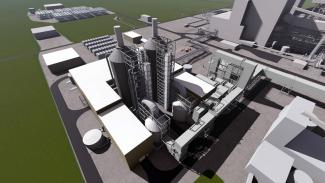Through a series of projects made possible with NETL funding and oversight, ION Clean Energy, Inc. (ION) has matured transformational carbon capture systems from early-stage research to pilot-scale testing — work that will help the U.S. Department of Energy (DOE) cut costs for crucial decarbonization technologies.
“NETL has been a part of many successful carbon capture projects undertaken by ION, and the development of their next-generation ICE-21 and ICE-31 solvent capture systems is another great example of how the Lab works with industry to mature systems from a low technology readiness level to pilot-scale testing,” said Katharina Daniels, federal project manager for several ION projects. “This technology development spans current and completed projects, and the systems have been or will be tested at many power generating stations across the country.”
In ION’s Project Apollo, which will be completed this summer, ION scaled up its water-lean, amine-based, third-generation ICE-31 capture solvent from bench scale to pilot scale using real flue gas at the National Carbon Capture Center (NCCC) in Wilsonville, Alabama. During testing, ICE-31 demonstrated excellent stability under challenging environments. The successful test campaign further validated the transformational performance of the technology, lowering capital and operating costs for carbon capture and facilitating progression to larger-scale pilot testing.
Results from Apollo are now being leveraged in the current Project Enterprise in which ION is advancing ICE-31 through engineering-scale (1 megawatt-electric) testing on a slipstream of flue gas from Calpine’s Los Medanos Energy Center (LMEC), a commercially dispatched natural gas combined cycle (NGCC) power plant in California. The LEMC project team will design, construct and operate a CO2 capture pilot system using ICE-31 solvent to capture 10 tonnes of CO2 per day, yielding a CO2 product flow with greater than 95% purity, suitable for compression and dehydration into a CO2 pipeline.
“In the LMEC project, the CO2 capture process will be optimized to take full advantage of the benefits provided by ION’s ICE-31 solvent in combination with other process improvements, all of which are derived through a process-intensification design philosophy focused on NGCC flue gas,” Daniels said. “The benefits of this holistic approach include a smaller physical plant, reduced energy requirements, improved CO2 product quality, less solvent degradation, lower emissions, lower water usage, less maintenance and lower capital costs.”
The ICE-31 projects leveraged ION’s process expertise that was refined by testing its second-generation, state-of-the-art solvent, ICE-21, at bench, small pilot and pilot scales with actual flue gases from power and industrial plants. For example, ION is wrapping up a front-end engineering and design (FEED) for a carbon capture system retrofit onto Unit 2 of Nebraska Public Power District’s Gerald Gentleman Station in Lincoln County, Nebraska. By using the optimized ICE-21 solvent capture system, the project demonstrated a reduction in energy requirements, solvent degradation and emissions compared to systems using baseline commercial solvents, decarbonizing as much of Unit 2 as possible while maximizing operational flexibility.
“FEED studies of carbon capture systems at operating host sites provide DOE with a more detailed understanding of carbon capture costs in a commercial application,” Daniels said.
ION recently kicked off another ICE-21 project to conduct a FEED study for retrofitting the ICE-21 system at another site — Calpine’s Delta Energy Center (DEC), an existing NGCC power station located in Pittsburg, California. The project team will perform design, engineering and analysis work to develop a cost estimate on the overall cost of capture and an analysis of the environmental, economic and social impacts to the Pittsburg-Antioch area.
The team intends to decarbonize DEC by capturing 95% of the CO2 emissions for geologic storage in the nearby Sacramento Basin. This carbon capture plant design effort will be designed to take full advantage of ICE-21’s benefits: a smaller physical plant, reduced energy requirements, less solvent degradation, lower emissions, and lower capital costs relative to systems built with commercial benchmark solvents. With the information developed through the project and discussions with commercial partners, Calpine will be able to make an informed decision on whether to proceed with deploying CO2 capture at DEC.
“The types of successes we are seeing with ION through support from the Office of Fossil Energy and Carbon Management are major decarbonization milestones,” Daniels said. “This and other important work with our project partners supports the transition towards a carbon pollution-free power sector by 2035 and a net-zero carbon pollution economy by 2050 while promoting creation of jobs located in power plant or industrial communities.”




